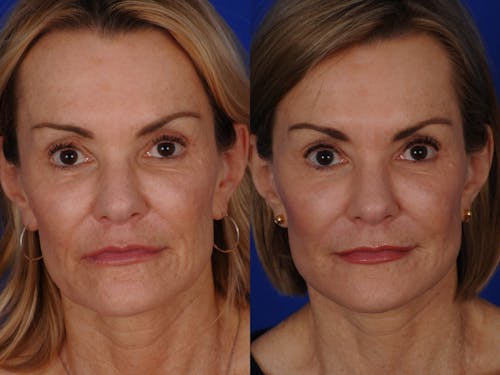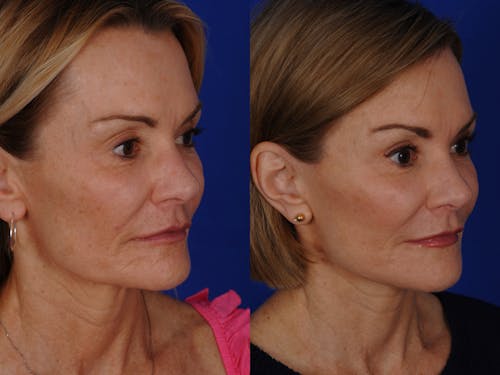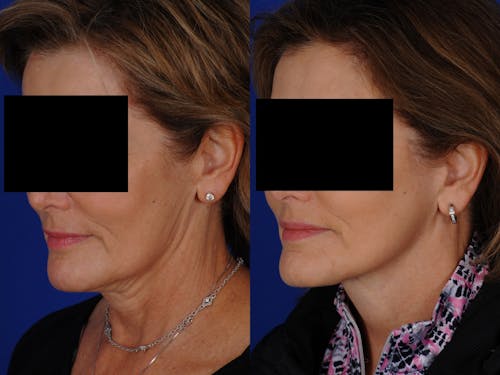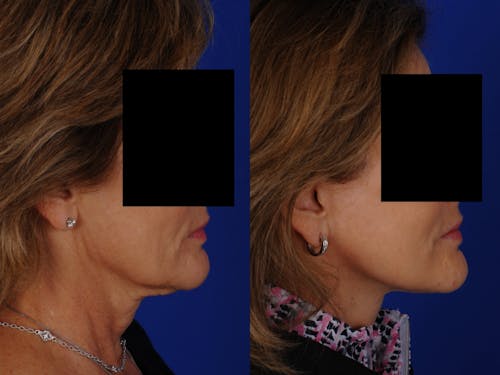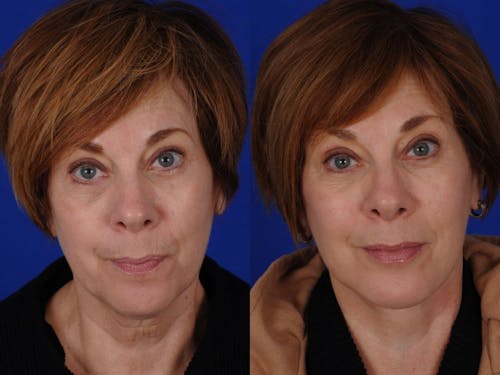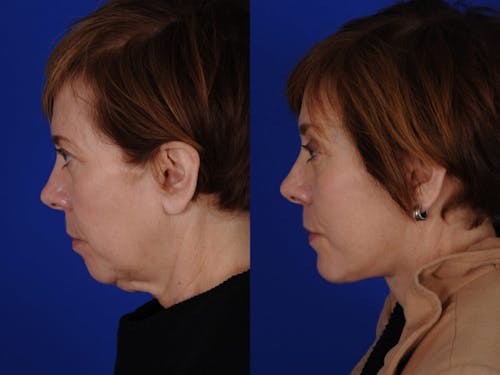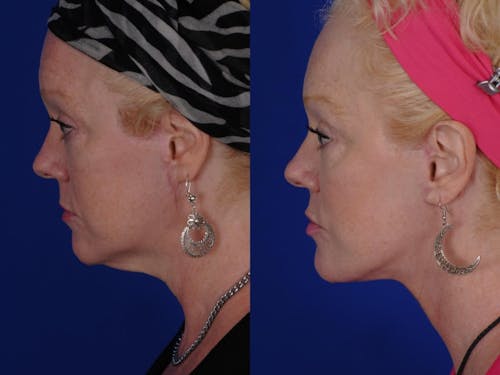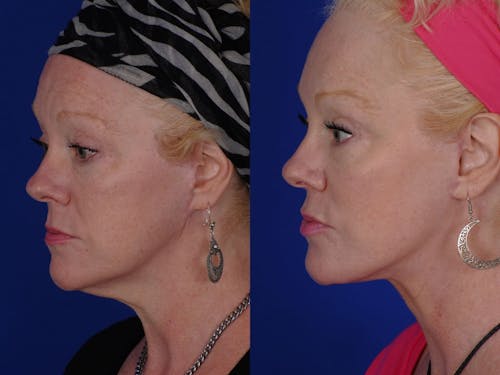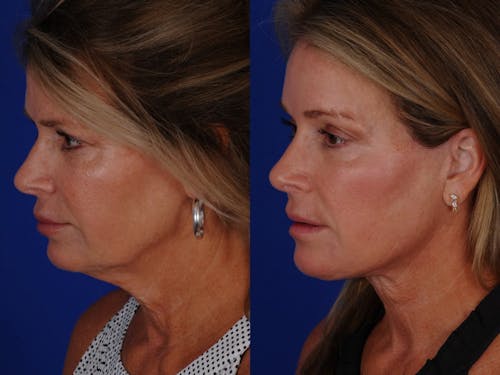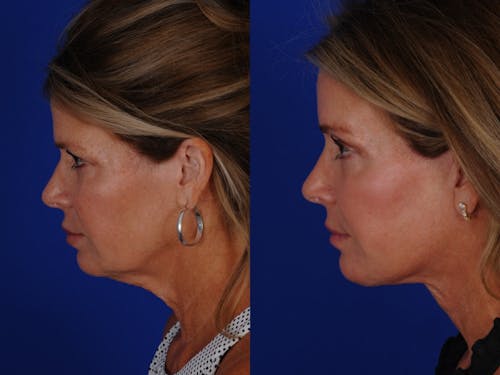A facelift, also known as a rhytidectomy, is a popular plastic surgery that restores a youthful appearance to the face by removing loose skin.

What is a Facelift?
The skin loses elasticity with age, which causes lines, wrinkles, and skin folds. During a facelift, Richmond facelift expert Matthew Bridges, MD, FACS, a facial plastic surgeon, surgically tightens deep facial tissue and excises the excess skin from the face. If you’re considering a facelift in Richmond, Dr. Bridges offers expert, personalized care to help you achieve natural-looking results.


Surgical Technique
Various techniques are used today to perform a facelift. Facial anatomy, skin laxity, and the patient's overall aesthetic goal will determine the best approach. Each procedure is unique to the patient and will vary based on the type and location of the incision, the number of tissue layers affected, the plane of elevation, and the level of invasiveness.


Types of Facelift
Skin Only Facelift
The skin-only facelift, also known as a cutaneous facelift, has existed since the early 1900s and addresses only the skin of the face. The problem with this technique is that the lifting places tension on the skin closure, causing the widening of scars. Because deep tissue and muscle are not tightened, the amount of contouring possible by affecting only the skin is minimal. For this reason, most modern facelift surgeons have abandoned this technique.
Traditional Facelift (SMAS)
The SMAS facelift is the more modern facelift technique. This surgery produces results that are more significant and longer lasting. The technique involves manipulating the tissue beneath the skin, known as the superficial musculoaponeurotic system (SMAS). This facial tissue layer connects with muscles in the neck. The SMAS and neck muscles (platysma) are tightened, creating youthful facial contours. Excess skin is then excised without tension, producing fine scars that are typically nearly invisible.
Richmond Mini Facelift
There are lots of "mini" facelifts described and advertised around the country. Most of the mini lifts also give mini results. They don’t usually create long-lasting results. Mini lifts typically involve incisions in front of the ear, without the typical extension of the incision into the hairline behind the ear. Dr. Bridges does not typically perform the type of mini-lift that gives minimal results. Instead, he offers a lifting procedure utilizing the state-of-the-art deep plane techniques achieved through a short scar typically used in mini-lifts. The facial tissues are elevated in the anti-gravitational vertical direction, which achieves the best correction of the sagging neck and jowls. Although the incisions are "mini," there is nothing "mini" about the result. For most patients, incisions in front of the ear are all that are needed. Sometimes, a short extension behind the ear and, occasionally, an incision under the chin are required. Dr. Bridges prefers this short scar, deep plane vertical lift technique and is one of the only facelift surgeons in Richmond who performs this type of advanced lifting procedure.
Richmond Deep Plane Lift
The deep plane lift goes a step further than the traditional approach by dissecting below the SMAS layer, which provides more tissue mobilization and greater lifting ability.
I LOVE what the microneedling has done for my skin - the tone and texture is unbelievable. Thanks for introducing me to Circadia, too - Love all the products you recommended. Am...
Dear Dr. Bridges, Thank you so much for your amazing work on my nose! I'm so thrilled with how it looks, and I couldn't be happier! I hope you have a great rest of your summer.
Dr Bridges takes the time to know his patients conditions and explains what must be done for treatment in user friendly language. staff is proficient and seems to genuinely care...
Dr. Bridges performed very complex surgery on my nose to repair a large loss to my left nostril due to cancer. At all times he ensured that I understood what the procedure would...
Extremely happy with the outcome of my nose surgery. I had sleep apnea....I was a true mouth breather. My nasal passages were thin slits! Dr Bridges gave me new cartilage ...
Dr. Bridges is an outstanding doctor. His easygoing personality and high level of expertise really set him apart from other doctors. He is a master of his craft and I know when ...
Dr Bridges is wonderful, so relatable and made me feel comfortable from the start. Thorough assessment that led to a wonderful result. Was sent to him for my deviated sept...
I had a most wonderful experience at this office. The staff are great and support the patient before/after surgery. I would tell everyone to come to this office. Dr. Bridges exp...
Truly an amazing experience. Franki explained the laser procedure with me and made me feel extremely comfortable. I would highly recommend commonwealth and Franki for any services!
Dr. Bridges is fantastic. I always wanted a rhinoplasty but I waited to find the right surgeon. He's patient, listens, and delivers excellent results. He also fixed my dev...
Super friendly staff. Dr Bridges did the impossible. I had gone to several consultations with plastic surgeons in the Richmond area to fix a surgery I had on my nose about...
I got a septo/rhinoplasty with Dr. Bridges and had an amazing experience! The process was seamless from start to finish. I felt prepared for surgery and had a quick and ea...
Dr. Bridges reminds me of the old time family doctors…empathetic, competent, efficient. I wish all of my doctors were like him. Additionally, he has surrounded hims...
Dr. Bridges performed my rhinoplasty in June 2024 and I couldn’t be happier with the results. I wanted a rhinoplasty for years but kept putting it off. My tip really...
Super friendly staff. Dr Bridges did the impossible. I had gone to several consultations with plastic surgeons in the Richmond area to fix a surgery I had on my nose about...
Dr Bridges performed a Lipoma removal procedure on my forehead and I am truly satisfied. He is an excellent physician. His nurse is awesome as well. I was extremely nervou...
Getting rhinoplasty to correct my larger nose has been a lifelong dream of mine, but the idea of doing it has always been scary/intimidating. Dr. Bridges and his team made...
I feel so grateful to have met Franki Lambiotte, the aesthetician at Dr. Bridges' practice!
I'd been interested in laser hair removal/reduction for...
My family have been patients at this practice for over 10 years. Franki Lambiotte has been wonderful with her services. My parents gave me laser hair removal packages as a...
Dr. Bridges is an amazing facial plastic surgeon, and we're so lucky to have him here in RVA. Amazing bedside manner, and actually listens to what you want to work with yo...
I’m blown away, pun intended. From the moment Dr. Shaia recommended Bridges, I have felt that my level of care was akin to what the president receives. The expertise...
Dr. Bridges is fantastic. I always wanted a rhinoplasty but I waited to find the right surgeon. He's patient, listens, and delivers excellent results. He also fixed my dev...
I had rhinoplasty by Dr. Bridges on November 20th 2019, almost 2 months ago. I had a great experience as a whole. Dr. Bridges was easy to talk to and his staff were all ve...
I was lucky enough to be one of the first of Franki’s clients to try the laser hair removal, Bare HR by Sciton, and loved the results on my legs and armpits. Franki ...
Franki has been my aesthetician for several years. I visit her every 2 or 3 months for either a hydrafacial or dermaplane facial. More recently, Franki recommended that I ...
In my teens, a mishap left my nose with a slight deviation and fractured. As the years passed, my nasal deviation worsened, turning my nose into something akin to a wilted...
For the past few years I’ve been watching the lines on my face getting deeper and jowls forming. It was when I started to see my neck sagging that it was time to get...

During/After Surgery
Most facelift procedures are performed under general anesthesia at an accredited surgical facility. The length of the surgery will vary, but it generally takes between 3-4 hours. This surgery is considered an outpatient procedure. However, some patients may be required to stay overnight in the hospital. After surgery, patients will be bruised and swollen, and their face and neck will feel tight. This will gradually improve within a few days. It is common to feel anxious about how the face will appear. However, patients need to understand it can take several months for the final results to show. Incisions typically heal rapidly and are hard to see, even after 3-4 weeks. If you’re preparing for a facelift in Richmond, knowing what to expect during recovery can help ease concerns and promote a smoother healing process.
Facelift FAQs
Is there a non-surgical alternative to a facelift?
Will I look fake?
Will the facelift leave visible scars?
What is the best age for a facelift?
Is there a non-surgical alternative to a facelift?
BOTOX®, injectable fillers, microdermabrasion, and chemical peels are non-surgical procedures that can help smooth out wrinkles, improve fine lines, and add facial volume. These procedures also help to even out skin tone. However, these treatments will only affect the skin’s surface. Patients with loose skin, drooping jowls, or a sagging neck will need to consider surgery if they want these features improved.
Will I look fake?
In the days immediately following facelift surgery, patients will feel tight and pulled. These are some short-term effects, but they will subside. It’s important to find a reputable surgeon skilled in facial surgery. Surgeons who know what they are doing will make every effort to work within the confines of the patient’s bone, skin, and muscle structures so a younger, more natural look can result.
Will the facelift leave visible scars?
Facelift surgery does require incisions. However, these scars are well hidden, as they fall just along the hairline and around the ears in the natural folds and shadows. In most cases, the scars are barely visible. Dr. Bridges' short scar deep plane vertical lifting technique limits the incision length to minimize scarring.
What is the best age for a facelift?
The common age range for patients who undergo a facelift is from the mid to late 40s and older. It is typical for most patients to look 5-10 years younger following a facelift procedure. Younger patients (40-50 years old) generally have stronger skin elasticity, so their results may last longer than older patients. However, older patients may have results that appear more dramatic, and, for them, this can be very worthwhile. Patients should think of a facelift as a process to turn back the aging clock. You will still age, but you will appear a few years younger.




